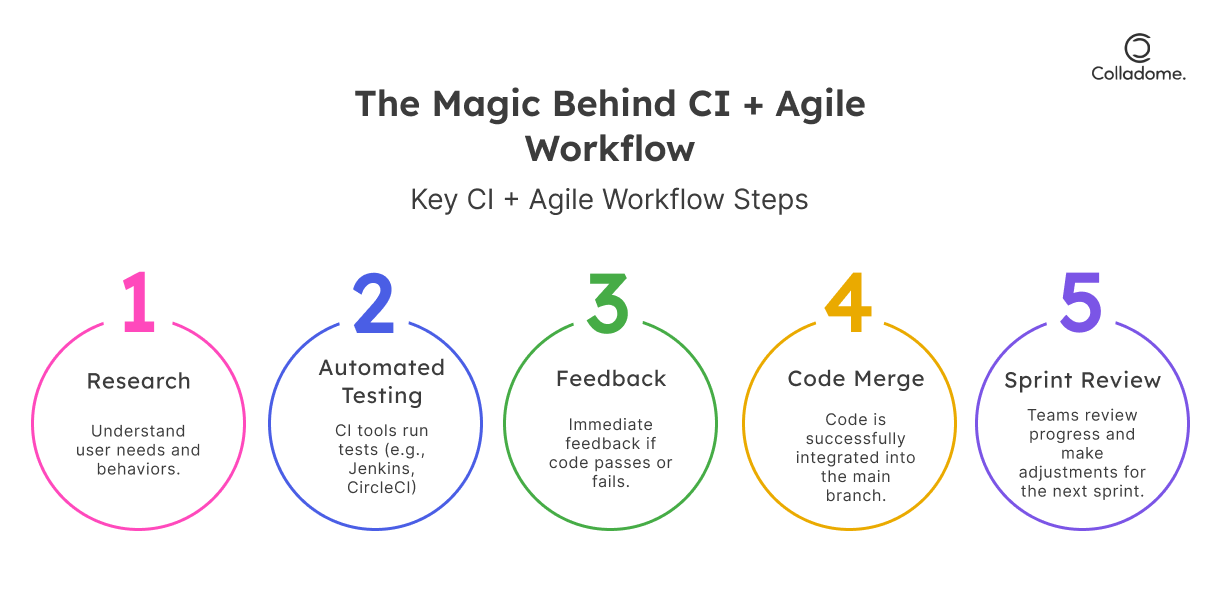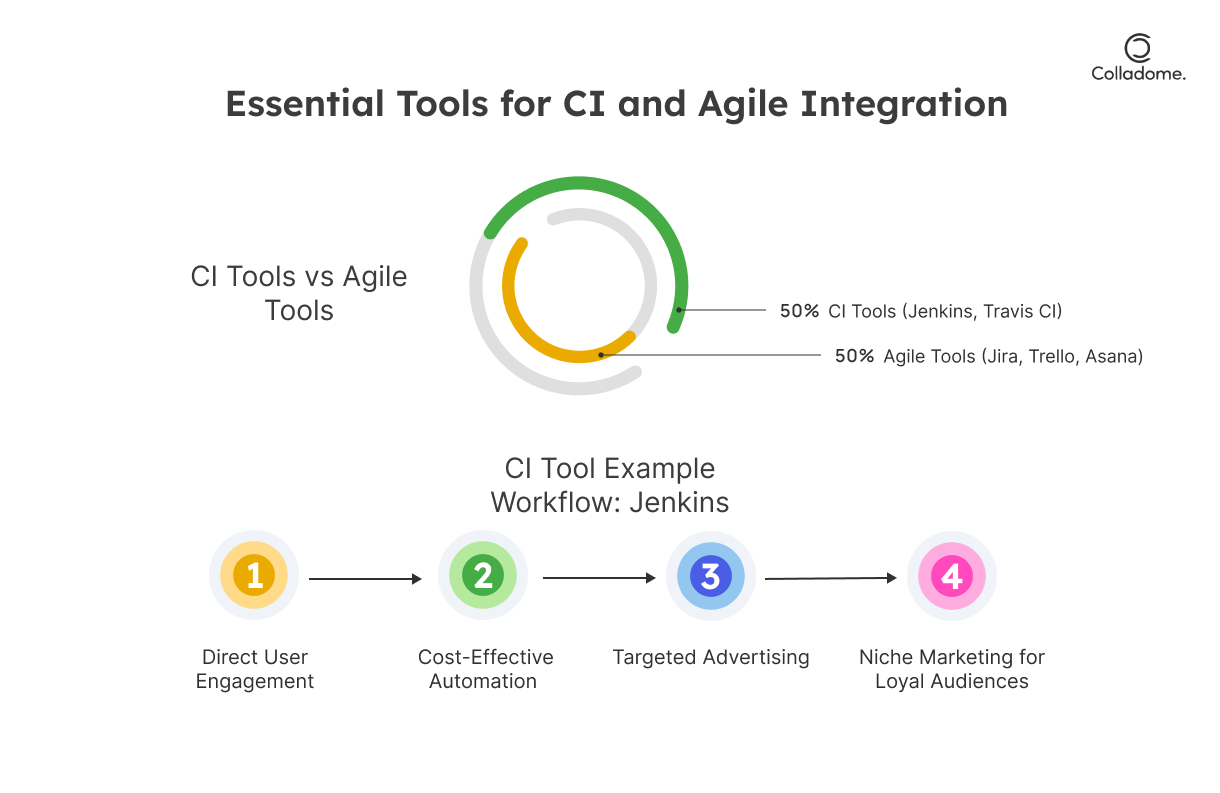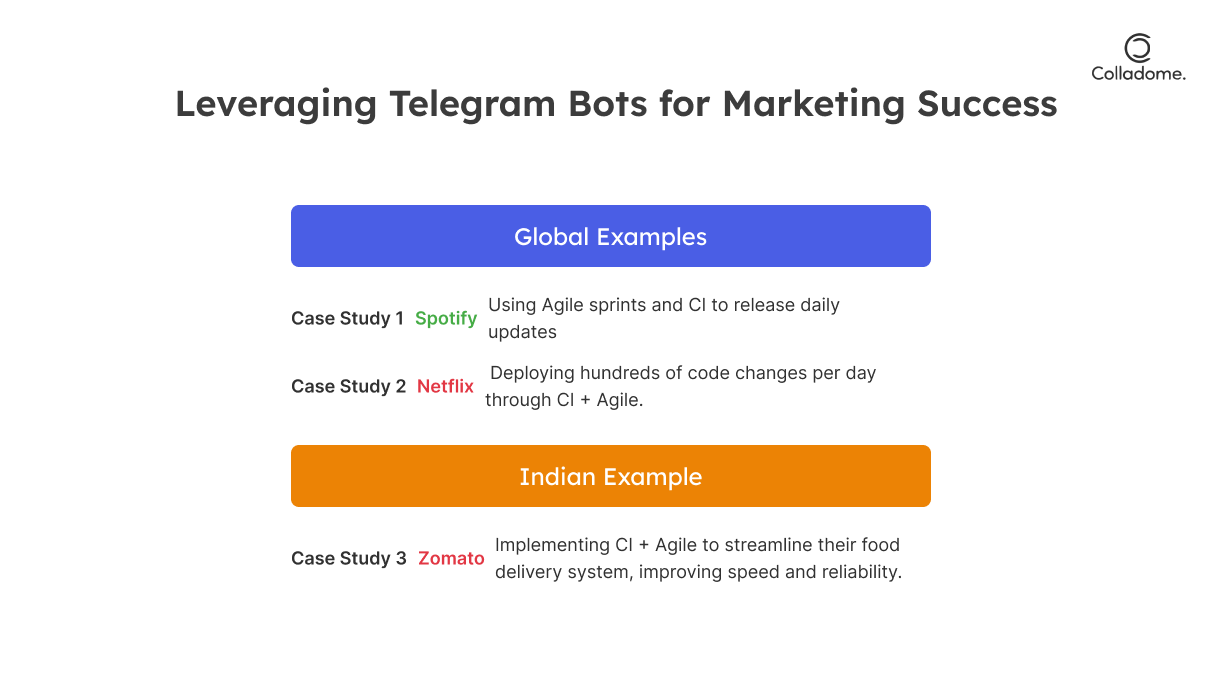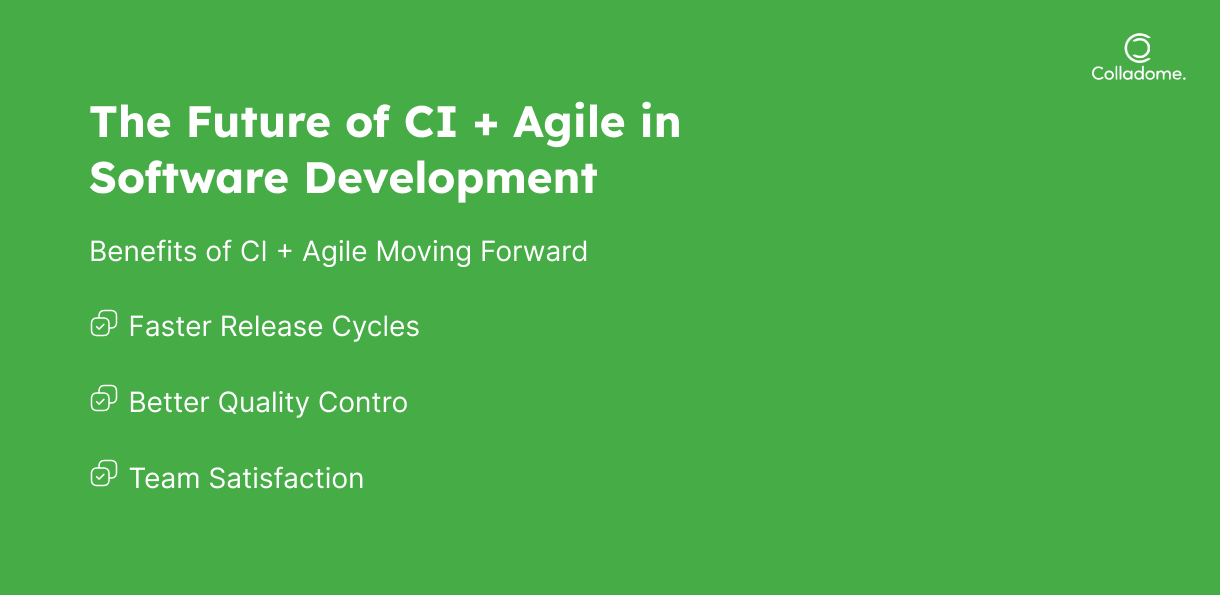“Fast, Reliable, and Agile! How Continuous Integration Powers the Speedy World of Software Development”
Introduction
In today’s cutthroat world of software development, speed and adaptability aren’t just nice-to-haves—they’re survival skills. That’s where Continuous Integration (CI) steps in, transforming how teams deliver software by integrating, testing, and deploying changes faster than ever. Now, pair that with Agile methodology, the ultimate playbook for collaboration and flexibility, and you’ve got a powerhouse duo that’s rewriting the rules of the game.

Think of CI as the fuel that keeps the Agile engine roaring. It’s not just about efficiency—it’s about revolutionizing how teams work, delivering updates with confidence, fixing bugs on the fly, and crushing deadlines without breaking a sweat. This blog will break down how continuous integration enhances Agile software development, the best practices for CI in Agile projects, and the top CI tools for Agile teams to supercharge your workflow.
If you’re ready to accelerate your sprints, outpace your competitors, and deliver flawless software faster than ever, keep reading. It’s time to unlock the full potential of CI and Agile—one sprint at a time!
Why Should You Care About Continuous Integration and Agile?
You’ve probably heard of Continuous Integration (CI) and Agile methodology—two buzzwords that dominate the world of software development. But here’s the kicker: when you combine them, you’re not just improving your process; you’re unleashing a productivity beast that transforms the way your team works. Let’s break it down, point by point, and see why this duo is the game-changer your team needs to adopt yesterday.
1. They’re the Batman and Robin of Software Development
Continuous Integration and Agile development aren’t just standalone heroes—they’re partners-in-crime for crushing inefficiencies. Agile brings collaboration, adaptability, and speed to your team, while CI ensures your codebase remains clean, tested, and deployable. Together, they create a workflow where code moves seamlessly from development to deployment without breaking a sweat (or your app).
2. Customer Demands Wait for No One
In today’s world, users expect flawless updates and features at lightning speed. Combining CI and Agile makes it possible to deliver frequent, high-quality releases that keep your customers happy and your competitors scrambling to catch up. This isn’t just about working faster; it’s about working smarter by integrating continuous feedback loops into your development process.
3. Bugs Don’t Stand a Chance
With CI, every code commit triggers an automatic build and test cycle, ensuring bugs are caught early—before they snowball into disasters. Pair this with Agile’s iterative approach, and you’re squashing issues in real time. The result? Your software ships with fewer defects and a whole lot more confidence.
4. It’s a Productivity Booster on Steroids
Let’s face it—manual testing and delayed feedback kill momentum. CI automates the grunt work, giving developers more time to focus on innovation. Meanwhile, Agile keeps your team laser-focused on delivering value in short, manageable sprints. Together, they create an environment where productivity soars, and burnout becomes a thing of the past.
5. Adapt or Get Left Behind
The pace of software development is brutal. Companies that fail to embrace modern practices like CI and Agile risk falling behind. These methodologies aren’t just nice-to-haves—they’re survival tools in a competitive industry. By combining them, you’re equipping your team with the agility to pivot, adapt, and thrive in an ever-changing market.
6. Tools Make It Easier Than Ever

Tools like Jenkins, Travis CI, and GitHub Actions make implementing CI a breeze, even for smaller teams. Pair these with Agile management tools like Jira or Trello, and you’ve got a streamlined system to keep everyone on track. It’s not about working harder; it’s about working smarter with the right tech.
7. Faster Delivery, Happier Customers
CI doesn’t just speed up your Agile software development process—it ensures that every sprint delivers real value. With shorter feedback loops and automated workflows, you’re accelerating delivery timelines while keeping quality high. That’s a win-win for both your team and your customers.
The Significance of Continuous Integration in Agile Development
Let’s break it down—here’s why Continuous Integration (CI) is the powerhouse behind Agile development and why your team should be all in:

1. CI Is the Glue That Holds Agile Together
- In Agile, where quick iterations are key, CI ensures that all team members integrate their code frequently.
- It eliminates the chaos of last-minute merges by catching conflicts early, keeping your software development process smooth and stress-free.
- Simply put, CI keeps your Agile engine running without a hitch.
2. Faster Delivery = Agile at Full Speed
- CI empowers Agile teams to release software updates quickly by automating builds and tests.
- Issues are detected in real-time, enabling teams to fix them immediately and stay on track.
- This is how continuous integration enhances Agile software development—by making it faster, cleaner, and more efficient.
3. Unmatched Collaboration
- CI fosters seamless collaboration between developers, testers, and product owners.
- Everyone works with the latest codebase, backed by automated test results and clear feedback loops.
- This shared transparency reduces miscommunication and ensures the team delivers a reliable product every sprint.
4. Early Risk Detection = Peace of Mind
- CI catches bugs early through automated testing with every code commit, reducing the likelihood of issues reaching production.
- Frequent integrations mean smaller, manageable risks rather than massive surprises at the end.
- This is the role of continuous integration in accelerating Agile software delivery—by removing hurdles before they become roadblocks.
5. Automation for the Win
- CI automates the tedious parts of software development, like running tests and creating builds.
- Tools like Jenkins, GitHub Actions, and Travis CI make it easier than ever to integrate CI into your process.
- With CI handling the repetitive tasks, developers can focus on innovation and creativity.
6. A Feedback Loop That Never Stops
- Agile thrives on continuous feedback, and CI delivers just that.
- Every code change triggers automated feedback, helping developers quickly address issues.
- This rapid iteration process ensures that each sprint delivers real, customer-focused value.
7. Reducing Bugs, Downtime, and Headaches
- By merging code often and testing constantly, CI reduces the chance of defects creeping into your application.
- Downtime is minimized, ensuring that your product maintains a stellar reputation in the market.
8. A Competitive Edge in Software Development
- Combining CI with Agile keeps you ahead of the competition by allowing you to release high-quality software faster than ever.
- If your team isn’t using CI in their Agile methodology, you’re leaving time, money, and opportunities on the table.
9. Scalability for the Modern Workflow
- As your codebase and team grow, CI scales with you, ensuring consistent integrations and automated processes across larger, more complex projects.
- It’s not just about surviving growth—it’s about thriving in it.
| Feature | Why It Matters | What It Feels Like |
| Frequent Code Merges | No more last-minute “merge hell”—everyone’s code integrates seamlessly. | Like a traffic-free highway during rush hour. Bliss. |
| Automated Testing | Bugs get caught immediately, not during a demo (yikes!). | Like having a hyper-vigilant watchdog sniffing out issues 24/7. |
| Real-Time Feedback | Developers know instantly if they’re building gold… or garbage. | Like your brutally honest best friend—straight to the point, every single time. |
| Risk Reduction | Small, frequent integrations = fewer nasty surprises in production. | Like a safety net that makes trapeze artists (or coders) fearless. |
| Speedy Deliveries | Push updates faster, better, and with fewer breakdowns. | Like a pizza delivery in under 10 minutes—hot, fresh, and impressive. |
| Collaboration That Clicks | Teams work in sync, with zero “But it works on my machine!” drama. | Like a band hitting every note perfectly. Goosebumps. |
| Scalability for Growth | Your workflow grows effortlessly with your team and codebase. | Like upgrading from a scooter to a sports car—without losing control. |
| Automation Magic | Tedious tasks? Gone. CI tools like Jenkins and GitHub Actions handle the grunt work. | Like hiring a robot butler for all your chores. |
| Competitive Edge | Faster releases + better quality = your product outshines the competition. | Like being the cool kid everyone’s talking about at school. |
What is Continuous Integration & Agile Methodology?
Let’s break this down and give it the spotlight it deserves. These two aren’t just buzzwords—they’re the bread and butter of modern software development. Here’s why:
Continuous Integration (CI)
Think of CI as your tech team’s safety net and speed booster combined. It’s all about integrating code into a shared repository constantly—not once a week, not once a day, but sometimes multiple times a day.

Here’s what makes continuous integration a non-negotiable in today’s Agile development world:
1. Automated Testing:
- Every time new code gets pushed, automated tests run like clockwork.
- Bugs? Missteps? Inconsistencies? Spotted immediately—long before they wreak havoc on your build.
- It’s like having a tech-savvy guardian angel ensuring your codebase stays in top shape.
2. Faster Feedback Loops:
- Developers don’t have to wait hours or days to know if their code works.
- The system tells them right away: “Nice job, genius!” or “Fix this mess, pronto!”
- This accelerates fixes and keeps the workflow ridiculously smooth.
3. Streamlined Collaboration:
- With CI, developers can work on different features of the project without stepping on each other’s toes.
- Merging changes? No drama. No “it works on my machine” excuses.
- It’s like a well-rehearsed orchestra—everyone plays their part, and the final symphony is flawless.
Agile Methodology

Now, pair CI with Agile methodology, and you’ve got the ultimate dream team. Agile isn’t just a way to develop software; it’s a mindset. It’s a way to embrace change, deliver value faster, and keep customers so happy they’ll never look elsewhere.
Here’s why Agile development is a total game-changer:
1. Flexibility at Its Core:
- Plans change. Requirements evolve. Customers want new things. Agile says, “Bring it on!”
- Unlike rigid processes, Agile thrives on adaptability, so you can pivot without breaking a sweat.
- How continuous integration enhances Agile software development? It gives Agile teams the tools to adapt even faster.
2. Collaboration is King:
- Agile teams work closely with stakeholders—no more “developer in the dark” situations.
- Product owners, developers, testers—everyone’s on the same page, ensuring the final product matches exactly what the customer needs.
3. Customer-Centric to the Core:
- Agile focuses on delivering working software quickly and iteratively.
- Customers don’t wait for months to see results—they get valuable updates now.
4. Short Sprints, Big Wins:
- Agile operates in short cycles (sprints), usually lasting 1-2 weeks.
- Each sprint delivers something usable, keeping progress visible and the team motivated.
CI + Agile: A Match Made in Software Heaven
Together, Continuous Integration and Agile Methodology are a powerhouse duo.
- Agile thrives on quick feedback and frequent iterations. CI ensures this happens seamlessly.
- The role of continuous integration in accelerating Agile software delivery can’t be overstated. It catches issues early, automates the tedious stuff, and allows teams to focus on innovating instead of firefighting.
How Does Continuous Integration Enhance Agile Software Development?
When you blend Continuous Integration (CI) with Agile methodology, you’re not just optimizing—you’re unlocking the full potential of software development. This combo is like having a turbocharged engine in a well-oiled car, delivering frequent releases with precision and quality. Let’s dive into how CI supercharges Agile practices:
1. Faster Development Cycles
- Agile thrives on speed—and CI is its secret weapon. By integrating code multiple times a day, developers avoid the dreaded merge conflicts that happen when changes pile up.
- Each integration triggers an automated pipeline of builds and tests, cutting down on manual work and accelerating progress.
- CI aligns perfectly with Agile’s sprint-based work structure, keeping iterations short, sharp, and productive.
- Why it matters: Faster cycles mean you’re not just delivering updates—you’re delivering them before your competition even hits “compile.”
2. Improved Quality Assurance (QA)
- Quality is at the heart of Agile development, and CI makes it non-negotiable.
- Automated testing is baked into the CI pipeline, acting like a watchdog for every new line of code. Bugs and regressions are identified immediately, long before they reach production.
- Think of CI as your 24/7 QA superhero—spotting issues, raising flags, and ensuring that every sprint ends with bug-free, customer-ready software.
- Why it matters: In Agile, delivering “done” software means delivering software that works flawlessly—and CI ensures you do that, sprint after sprint.
3. Collaborative and Transparent Development
- Agile preaches collaboration—and CI puts it into action. With continuous feedback loops, team members are always on the same page.
- Integration issues (a.k.a. the silent killers of productivity) are detected and resolved in real-time, fostering a transparent, blame-free development culture.
- CI also improves collaboration between developers, testers, and product owners by automating repetitive tasks and focusing their energy on problem-solving and innovation.
- Why it matters: No one likes the “It works on my machine” excuse. CI eliminates it, creating a single source of truth for your entire Agile team.
4. Continuous Delivery of Value
- Agile isn’t just about speed—it’s about delivering value incrementally. CI makes this happen through automated deployments.
- Teams can roll out features more frequently, ensuring customers get a steady stream of updates instead of waiting for massive, risky releases.
- CI supports continuous delivery, meaning your software is always in a releasable state. Pair this with Agile, and you’ve got a feedback loop that keeps improving with every sprint.
- Why it matters: Agile’s ultimate goal is to put working software into customers’ hands faster. CI guarantees that each release adds value, not frustration.
5. Minimized Risk, Maximized Efficiency
- In Agile, the cost of failure is high—missed deadlines, unhappy customers, and endless rework. CI minimizes this risk by catching problems early and often.
- Frequent code integrations mean small, manageable changes rather than massive, risky merges.
- Automated pipelines reduce manual errors, free up developer time, and streamline the entire software development lifecycle.
- Why it matters: By reducing risks and increasing efficiency, CI lets Agile teams focus on what matters—innovating and delivering.
| Feature | What It Does | Why It’s Awesome |
| Automated Testing | Catches bugs early with every code change. | No more “It broke production!” panic moments. |
| Fast Feedback | Alerts developers instantly when something’s off. | Fix issues fast and keep the team sharp. |
| Team Collaboration | Keeps everyone’s work in sync. | No more “It works on my machine” excuses. |
| Quick Deliveries | Speeds up feature releases. | Customers get updates faster—no late-night firefights. |
| Risk Reduction | Identifies issues early to avoid disasters later. | Reliable releases, every time. |
Best Practices for Implementing Continuous Integration in Agile Projects
When you’re diving into Continuous Integration (CI) within an Agile project, following best practices isn’t just a nice-to-have—it’s a must. Here’s how to make CI really work for your team:
1. Automate Everything!
What It Means: Build, test, deploy—automate it all.
Why It Rocks: You’re a developer, not a manual tester. Automation lets your team focus on innovation instead of endless testing cycles. Plus, no one loves clicking buttons all day. CI tools got your back.
2. Frequent Commits Are Key
What It Means: Commit code at least once a day—more if possible.
Why It Rocks: “Integration hell” is a nightmare. Avoid merging massive chunks of code at the last minute. Small, frequent commits mean fewer conflicts, and more stable builds. The smoother the integration, the smoother the sprint.
3. Run Unit Tests Early (Like Yesterday)
What It Means: Integrate unit tests right from the start of the cycle.
Why It Rocks: Bugs don’t stand a chance. The earlier you catch issues, the easier (and cheaper) they are to fix. Plus, unit tests give you instant feedback on code quality.
4. Keep Your Builds FAST
What It Means: No one likes waiting forever for a build to complete.
Why It Rocks: Fast builds mean quicker feedback, which keeps the momentum high. If builds are slow, developers will avoid committing, and you’ll miss out on the magic of CI. Speed = Success.
5. Monitor and Analyze CI Reports
What It Means: Don’t just run CI—watch it.
Why It Rocks: You can’t fix what you can’t see. Regularly monitoring your CI reports helps identify issues before they spiral out of control. This proactive approach ensures you’re always on top of things.
Real-Time Examples of Successful CI and Agile Adoption
Here’s a glimpse of how Continuous Integration (CI) and Agile methodologies are shaking up the world of software development, both in India and globally. These companies aren’t just talking the talk—they’re walking the walk, and the results speak for themselves:
1. Flipkart (India)
The Challenge: Flipkart, one of India’s largest e-commerce platforms, was facing a major issue with slow release cycles, bugs popping up all over the place, and the usual chaos of late-stage integration.
How CI + Agile Helped: Flipkart went all in on Agile and Continuous Integration to speed up their process. By integrating code frequently, they could tackle bugs early and deploy faster. Flipkart’s adoption of CI meant that testing was automated, and updates went out regularly without a hitch.
Results:
- 40% reduction in testing time
- 25% increase in deployment frequency
- Bug fixes and updates are now faster than a lightning sale!
2. Ola Cabs (India)
The Challenge: Ola’s development teams were struggling with long delays between iterations of their mobile app updates, which led to prolonged downtime and sluggish response times to user feedback.
How CI + Agile Helped: Ola embraced Agile sprints along with CI to continuously integrate their code and push updates on the go. With CI, they stopped waiting around for the “perfect moment” and instead integrated and tested continuously, minimizing disruptions and maximizing uptime.

Results:
- Faster updates and deployments
- Reduced downtime
- Quick responses to shifting market demands and user feedback. Ola’s app is smoother than a midnight ride!
3. Netflix (Global)

The Challenge: Netflix serves millions of customers worldwide, and any hiccup in their service could send viewers straight to their competitor’s platform. Netflix needed a rock-solid method to update their software without ever disrupting the viewing experience.
How CI + Agile Helped: Netflix took the best practices from Agile development and powered it with Continuous Integration. Daily deployment cycles meant new features and bug fixes could roll out seamlessly to millions of users every day—without any downtime or drama.
Results:
- 1000+ deployments per day—yes, per day!
- Users are enjoying smooth, uninterrupted content streaming. No buffering, no waiting!
4. Amazon (Global)
The Challenge: With millions of transactions every second and a vast software ecosystem, Amazon needed to be agile. They were looking for a way to keep their software updates as quick and seamless as possible while maintaining top-tier quality.
How CI + Agile Helped: Amazon implemented CI as the backbone of its massive software infrastructure. Automated testing and CI tools helped Amazon continuously test, deploy, and update their systems—ensuring high availability and efficiency across their e-commerce platforms.
Results:
- Hundreds of updates per day (Yes, hundreds!)
- Super-fast response times and zero downtime. Amazon’s e-commerce empire is fueled by CI + Agile.
Statistics
- 82% of software development teams have adopted Agile methodologies. (source)
- 93% of Agile teams say Continuous Integration helped them deliver higher-quality software. (source)
- 35% faster time to market for teams that use CI in Agile projects. (source)
- Teams practicing CI see 60% fewer deployment failures. (source)
- Agile teams with CI/CD pipelines experience improved developer productivity by 20%. (source)
Conclusion
In today’s competitive landscape, Continuous Integration (CI) paired with Agile methodologies isn’t just a nice-to-have—it’s a must. With CI, you get constant feedback on your code, catching bugs early and ensuring faster delivery. When combined with Agile, you get the power of rapid, iterative development with a focus on quality. This dynamic duo transforms your development cycle, enhancing collaboration and pushing quality code out at lightning speed.

In short? CI and Agile aren’t the future—they’re the now. If you’re not on this train, you’ll be left in the dust.
At colladome We get it—CI + Agile is the powerhouse that drives success in software development. At Colladome, we bring this vision to life with the right tools and frameworks, so you can develop faster and smarter. Ready to level up? Let’s make it happen.
Call to Action
If you’re still not using Continuous Integration with Agile, it’s time to step up your game. Here’s how to get started:
- Automate your tests: Let your CI tools handle the heavy lifting.
- Integrate frequently: The more often you integrate, the faster you get feedback.
- Speed up your builds: No one likes a slow pipeline.
At Colladome, we specialize in Agile-driven CI solutions that boost your development speed and code quality. From streamlining your process to integrating CI tools, we help you stay ahead of the game. Visit Colladome and let’s take your software development to the next level.






